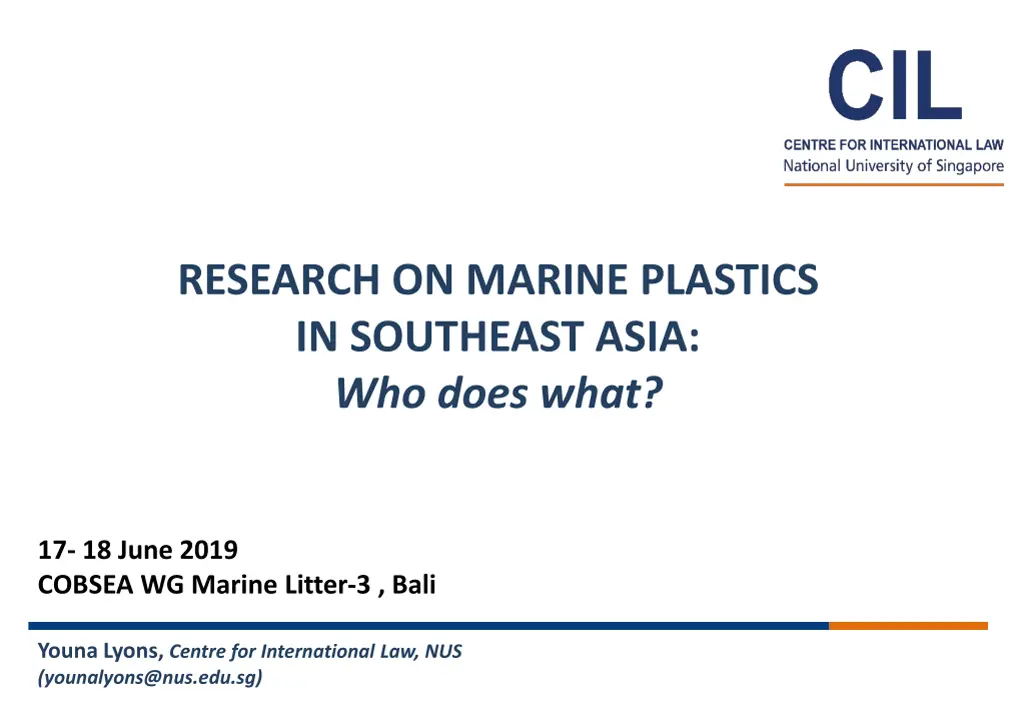
Marine Plastics Research in Southeast Asia: Findings and Initiatives
Explore the research on marine plastics in Southeast Asia, including insights into natural sciences findings, regional initiatives, and global frameworks. Discover the methodology, key players, and proposed action plans in combating marine plastic pollution in the region.
Download Presentation

Please find below an Image/Link to download the presentation.
The content on the website is provided AS IS for your information and personal use only. It may not be sold, licensed, or shared on other websites without obtaining consent from the author. If you encounter any issues during the download, it is possible that the publisher has removed the file from their server.
You are allowed to download the files provided on this website for personal or commercial use, subject to the condition that they are used lawfully. All files are the property of their respective owners.
The content on the website is provided AS IS for your information and personal use only. It may not be sold, licensed, or shared on other websites without obtaining consent from the author.
E N D
Presentation Transcript
RESEARCH ON MARINE PLASTICS IN SOUTHEAST ASIA: Who does what? 17- 18 June 2019 COBSEA WG Marine Litter-3 , Bali Youna Lyons, Centre for International Law, NUS (younalyons@nus.edu.sg)
Background and Scope Natural evolution of on-going work of NUS on different aspects of marine plastics in the region Focus on research in natural sciences and programmes and initiatives that involve governments in the region, directly or indirectly Little socio-economic analysis involving the private sector Funding from the United Kingdom The information contained in this version 1 is true as off 15 May 2019. We hope to continue the work in a version 2 that would be updated, more comprehensive and built-in comments from the region
Methodology and Structure Research based on systematic review of published scientific literature, internet research with a series of keywords and authors work in different programmes on this topic including participation to working groups at the IMO (Marine Environmental Protection Committee, PPR, London Convention/London Protocol). Part 1- Marine plastic research in each ASEAN Member State Context, status of understanding, main players, gaps, events hosted Part 2- Programmes/initiatives in regional bodies: ASEAN, COBSEA, etc. Part 3- Global frameworks relevant to Southeast Asia Part 4- Notable partnerships (incl. public-private) Part 5- Comparative analysis
Findings in natural sciences Areas of research: survey and monitoring, source differentiation, hotspots, ecological and environmental impacts, ALDFG
Findings in review of work by regional and global bodies and initiatives
Findings in the work of regional and global bodies and initiatives - policy, laws, administrative measures - Action Plans, guidelines and standards - Public outreach/beach clean-up - Language and cultural barriers, data accessibility - Upstream research/circular economy - Research framework, coordination - Survey and monitoring/pollution status - Methodology for monitoring and assessment - Source differentiation, - Contribution of fisheries - Contribution from offshore activities - Accumulation zones - Ecological and environmental impact - Microplastics, etc 20 Research Topics Identified
Gaps and Priorities Research priorities: Surveys and monitoring Source differentiation Accumulation zones & hotspots Ecological and environmental impact Contribution of fisheries/lost and abandoned fishing gear Gaps in research: Methodology for the monitoring and assessment of marine litter Contribution from rivers/river basin management Fragmentation and degradation Issues related to the deliberate or abandonment of waste at sea Risk assessment approach to prioritization Consider also potential gaps in research
How In addition to needed research and grants administered in the region, Improve coordination at regional level [All three SDs & several actions in the AP esp. Action 4 ] Develop a network of regional institutions/research centres that play a complementary role could be based on on-going programmes to harvest existing know-how Regional knowledge management platform that links existing work to assist stakeholders in the region Flow of information: Consider ways to engage local communities in effort and developing discussion groups or information forum to break the silos
